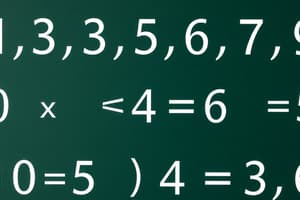Podcast
Questions and Answers
Which of the following is NOT a type of number?
Which of the following is NOT a type of number?
- Rational numbers
- Irrational numbers
- Fractional numbers (correct)
- Whole numbers
The area of a rectangle can be calculated using the formula length × width.
The area of a rectangle can be calculated using the formula length × width.
True (A)
What is the main focus of differential calculus?
What is the main focus of differential calculus?
Calculating rates of change
An example of an irrational number is ______.
An example of an irrational number is ______.
Match the following types of angles with their definitions:
Match the following types of angles with their definitions:
Which property of arithmetic states that changing the order of the numbers does not change the result?
Which property of arithmetic states that changing the order of the numbers does not change the result?
A linear equation can represent a straight line.
A linear equation can represent a straight line.
What do the measures of central tendency include?
What do the measures of central tendency include?
Flashcards
What is Mathematics?
What is Mathematics?
Mathematics is a broad field that studies numbers, shapes, and patterns, using abstract concepts and rules to understand relationships and solve problems. Different branches include arithmetic, algebra, geometry, calculus, and statistics.
What are the basic operations in arithmetic?
What are the basic operations in arithmetic?
The basic operations in arithmetic are addition, subtraction, multiplication, and division. These operations are used to combine and manipulate numbers, forming the foundation of more advanced mathematical concepts.
What are integers?
What are integers?
Integers are whole numbers, including positive numbers, negative numbers, and zero. They can be represented on a number line, extending infinitely in both directions.
What is the difference between rational and irrational numbers?
What is the difference between rational and irrational numbers?
Signup and view all the flashcards
What is the purpose of algebra?
What is the purpose of algebra?
Signup and view all the flashcards
What are the key concepts in geometry?
What are the key concepts in geometry?
Signup and view all the flashcards
What is Calculus used for?
What is Calculus used for?
Signup and view all the flashcards
What are the main goals of statistics?
What are the main goals of statistics?
Signup and view all the flashcards
Study Notes
Fundamental Concepts
- Mathematics is a broad field encompassing various branches, including arithmetic, algebra, geometry, calculus, and statistics.
- It deals with abstract concepts like numbers, shapes, and patterns and their relationships.
- Basic mathematical operations include addition, subtraction, multiplication, and division.
Arithmetic
- Arithmetic focuses on the basic operations on numbers.
- Natural numbers (1, 2, 3, ...) are used for counting.
- Whole numbers (0, 1, 2, ...) include zero alongside natural numbers.
- Integers include negative numbers, zero, and natural numbers.
- Rational numbers can be expressed as a fraction p/q where p and q are integers, and q is not zero. Examples include 1/2, 3/4, -2/5.
- Irrational numbers cannot be expressed as a fraction of two integers. Examples include π (pi) and the square root of 2.
- Real numbers encompass all rational and irrational numbers.
- Fundamental arithmetic properties include the commutative, associative, and distributive properties.
Algebra
- Algebra uses symbols (variables) to represent unknown quantities and relationships.
- It allows the generalisation of arithmetic operations.
- Solving equations involving variables is a core concept.
- Expressions combine variables, constants, and operations.
- Equations state that two expressions are equal.
- Inequalities show relationships between expressions using symbols like <, >, ≤, ≥.
- Linear equations represent straight lines on a graph.
- Quadratic equations represent curves.
Geometry
- Geometry deals with shapes, sizes, and positions of objects in space.
- Basic shapes include points, lines, angles, triangles, squares, circles, and cubes.
- Different types of angles are acute, obtuse, right, straight, and reflex.
- Concepts include perimeter, area, and volume.
- Geometric theorems describe relationships among shapes.
Calculus
- Calculus involves calculating rates of change, areas, and volumes.
- Differential calculus deals with instantaneous rates of change, represented by derivatives.
- Integral calculus deals with accumulated amounts or areas under curves, represented by integrals.
- Applications include modelling motion, growth, and optimization problems.
Statistics
- Statistics involves collecting, organizing, analyzing, and interpreting data.
- Data can be represented through charts, graphs, tables, etc.
- Measures of central tendency include mean, median, and mode.
- Measures of dispersion include variance and standard deviation.
- Statistical methods are used to draw inferences and make predictions.
Sets
- Sets are collections of objects, numbers, or other mathematical entities.
- Set operations include union, intersection, and difference.
- Set theory provides a formal language for working with sets.
- Concepts like subsets, supersets, and empty sets are studied.
Logic
- Logic studies the structure of valid arguments.
- Concepts like statements, logical operators (and, or, not), and quantifiers (all, some, none) are used.
- Mathematical proofs depend on logical structure.
Number Theory
- Number theory focuses on properties of integers and their relationships.
- Concepts include prime numbers, divisibility, and modular arithmetic.
Studying That Suits You
Use AI to generate personalized quizzes and flashcards to suit your learning preferences.




